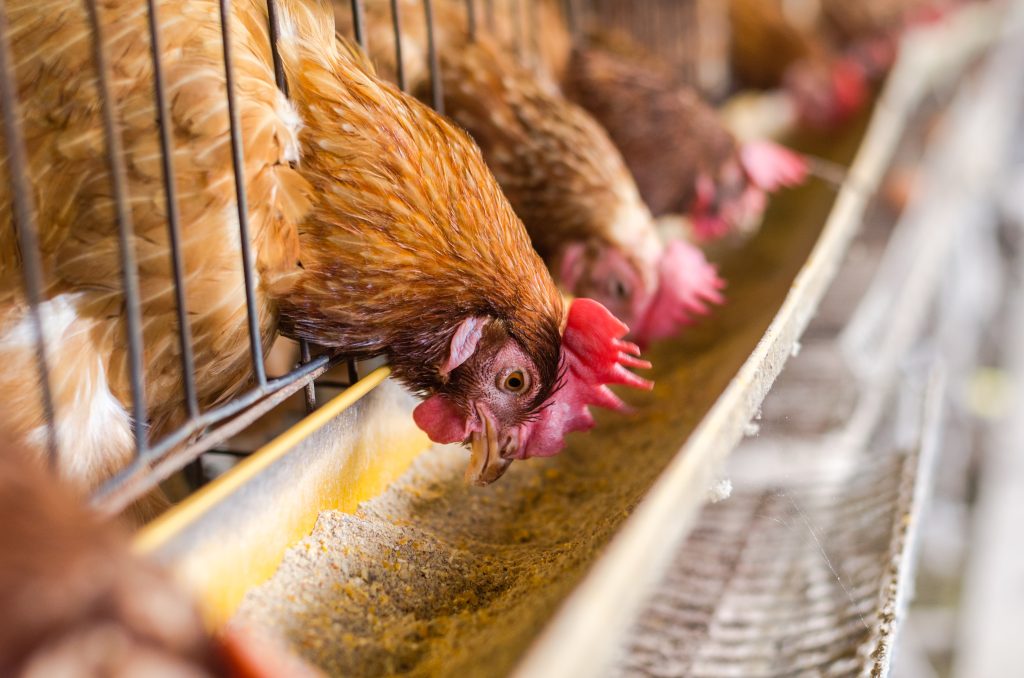The EU restrictions on animal by-products have shifted poultry feeds toward vegetable fats like soybean and palm oil, increasing the risk of oxidation due to their unsaturated nature. Combined with the variable stability of food-processing by-products, this makes modern poultry feed formulations more prone to rancidity and nutrient loss. Natural tocopherols help counteract these effects by preserving feed quality during storage and supporting the bird’s antioxidant defenses.
This article examines oxidation mechanisms, the protective role of tocopherols, and best practices for their use in poultry feed.
Mechanisms of rancidity and lipid degradation in poultry feed
Rancidity in poultry feed is primarily the result of lipid oxidation, a series of chain reactions initiated by reactive oxygen species (ROS), light, heat, and metal ions. Unsaturated fatty acids, especially those found in common vegetable oils like soybean and palm, are particularly susceptible to oxidative deterioration. These reactions generate peroxides, aldehydes, and ketones, which not only impart off-flavors and odors but also reduce the digestibility of nutrients and the bioavailability of amino acids and vitamins.
Transition metals, such as iron and copper, can catalyze oxidation through redox cycling, accelerating the breakdown of lipid hydroperoxides into additional free radicals, thereby further perpetuating the reaction. The degradation of these lipids produces cytotoxic by-products that may interact with other dietary components, compromising their functionality and leading to a cascade of nutritional imbalances.
The result is a significant drop in feed intake, average daily gain, and feed conversion ratio. Poultry’s consumption of oxidized feed has been linked to tissue damage, leaky gut syndrome, and oxidative stress-related myopathies such as woody breast and white striping in poultry meat, which negatively impact carcass quality and shelf life. It results in alterations to the texture, color, odor, taste, and nutritional value of meat, which has a significant impact on consumers’ acceptance and, therefore, successful production.
How natural tocopherols improve poultry feed shelf life
Natural tocopherols, especially D-alpha-tocopherol (natural vitamin E), are fat-soluble compounds with strong antioxidant properties that interrupt the oxidative chain reactions by neutralizing lipid radicals. Unlike synthetic antioxidants like BHT or propyl gallate, natural tocopherols are derived from plant-based sources and align with clean-label demands in the animal nutrition industry.
Vitamin E, when incorporated into poultry feed in its natural form, serves a dual function: it protects the feed matrix from oxidation and supports the animal’s internal antioxidant defense systems. During storage, tocopherols prevent the peroxidation of unsaturated fats by donating hydrogen atoms to lipid radicals, forming stable tocopheroxyl radicals that do not propagate further oxidative damage.
Once ingested, natural tocopherols help reduce oxidative stress in birds by stabilizing cellular membranes and scavenging ROS generated during metabolism or due to external stressors.
Importantly, the degree of oxidative stress a bird experiences during its life directly influences the susceptibility of its meat to spoilage after slaughter. Due to the high content of unsaturated fatty acids in poultry muscle, post-mortem lipid oxidation can progress rapidly. Birds with depleted antioxidant reserves, often a result of ingesting oxidized feed, lack the endogenous protection needed to slow this process, leading to greater deterioration in the quality and stability of the final meat product.
Furthermore, tocopherols are especially effective in matrices high in polyunsaturated fatty acids (PUFAs), such as those found in linseed or fish oil-enriched diets. Without sufficient antioxidant protection, these diets can rapidly deplete tissue Vitamin E levels and significantly elevate markers of lipid peroxidation.
Formulating poultry feed with tocopherols for maximum efficacy
To achieve optimal efficacy, several factors must be considered when formulating poultry feed with natural tocopherols.
First, the antioxidant capacity of the feed must match the oxidation potential of its ingredients. This requires a careful assessment of the fatty acid profile, storage conditions, and presence of pro-oxidant elements such as transition metals.
Secondly, tocopherols should be applied in combination with other synergistic antioxidants where appropriate. For example, citric acid can be used as a metal chelator to neutralize the pro-oxidant effects of trace minerals, enhancing the efficacy of tocopherols in rancidity prevention. Ascorbic acid (vitamin C) also helps regenerate oxidized tocopherols, restoring their antioxidant function.
In practice, the inclusion of D-alpha-tocopherol at levels tailored to the oxidative challenge of each feed formulation is key. Higher inclusion rates may be warranted in feeds enriched with PUFAs or those stored under suboptimal conditions.
Btsa has developed Oxabiol® Blends, a range of natural and semi-natural antioxidants that combine tocopherols with different ingredients, seeking a synergistic effect that increases the oxidative stability of the product. We develop customized and tailored synergistic blends of antioxidants according to your needs. They protect fatty components against oxidation without altering the palatability of the product.
A balanced antioxidant strategy will not only preserve the nutrient profile of the feed but also reduce the incidence of performance variability often attributed to undetected oxidative degradation. When implemented correctly, our natural antioxidants in poultry feed contribute to consistent bird performance, better feed efficiency, and superior end-product quality.

